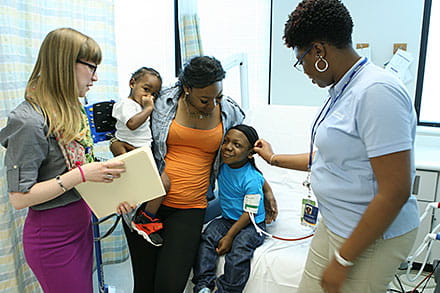Health Network Bridges Gaps for Medicaid Families

Shawn’tez Thompson benefits from the support of a case management team that helps his mother coordinate his care.
Six-year-old Shawn’tez Thompson dashes past his mom, Ka’cee, and little brother, Mon’tez, and hops into a treatment chair in the Dialysis Unit at Cincinnati Children’s. Surprised by his speed and energy, a staffer asks about his wheelchair.
“Today’s a good day,” says Ka’cee, “so we left it at home.”
Shawn’tez and his family are having more good days lately, thanks to their enrollment in the Health Network by Cincinnati Children’s.
Shawn’tez suffers from cystinosis, a rare disorder that can lead to kidney failure. He’s on the waiting list for a kidney transplant. While he waits for a kidney to be available, he needs dialysis several times a week. After he has the transplant, he’ll need orthopaedic surgery to repair bone damage caused by rickets, a complication of his condition. “We’re just getting started,” says Ka’cee. “It’s going to be a long road.”
Fortunately, she won’t be walking it alone. As a member of the Health Network, Ka’cee gets support from a case management team that includes a nurse, social worker and community health worker who help her coordinate her son’s care and navigate the complexities of the healthcare system.
Designed to Meet Families’ Needs
Cincinnati Children’s launched the Health Network on July 1, 2013. It currently has contracts with two of Ohio’s five designated Medicaid managed care insurance companies to serve children in Southwest Ohio.
Every health management network is different. The Cincinnati Children’s approach is to create a comprehensive system built around families’ needs. “We designed the Health Network by Cincinnati Children’s from the ground up to meet the needs of our community,” says Terry Lindquist, executive director.
“Our vision is that all children receive their care in a family-centered medical home, where both clinical and non-clinical services are easily accessed,” says Colleen Kraft, MD, the Health Network’s medical director.
The Health Network uses sophisticated information technology as well referrals from insurance companies and physician offices to identify families who might benefit from help coping with complex needs. Then nurse care managers reach out to these families to offer case management.
Regardless of where the child’s medical home is − whether in the Pediatric Primary Care Center at Cincinnati Children’s or in the community − if the child is a member of the Health Network, the family has access to the Health Network’s team of nurse care managers, social workers, community health workers, project coordinators and mental health facilitators.
Medicine and More
Of the Health Network’s nearly 35,000 members, 150 are enrolled in high-risk case management.
Based on a detailed assessment of the family’s needs, the care management team collaborates with the family to develop a care plan and establish goals for the child. They link families to a medical home. They track immunizations, hospitalizations, emergency room visits, clinic appointments and medications. They fill gaps in care, eliminate barriers and connect families to community resources.
For some children, like Shawn’tez, a complex medical condition presents the family with day-to-day challenges.
“The Health Network has made life less crazy and chaotic for us,” says Ka’cee. “When I didn’t know where to get medical supplies, they connected me. When his medicine doesn’t come on time, I call, and they get it to me pronto. They put me in touch with a lot of resources so we can get the things we need. It saves me a lot of running around.”
For other families, the most immediate and pressing challenges may be unsafe or substandard housing, lack of heat in the winter, the threat of eviction, lack of food or lack of transportation to the doctor’s office.
Physician’s offices are not equipped to handle all the social issues, points out Kraft.
But recognizing that these issues significantly affect child development and health outcomes, Cincinnati Children’s built the Health Network to provide wrap-around services to address urgent social as well as medical issues.
While much of the support is provided by phone, community health workers meet families in person at least every 90 days. “I am the eyes and ears of the care manager,” says community health worker Maya Wallace. “I give the care manager a very detailed description of what I see. It makes a big difference because some things aren’t obvious in a phone conversation.”
“Our goal is to minimize family stress so parents can focus on their child’s healthcare,” says social worker Liz Monaghan, MSW, LISW − and at the same time, “we’re teaching the parents skills they can use to help their child for the rest of their life.”



